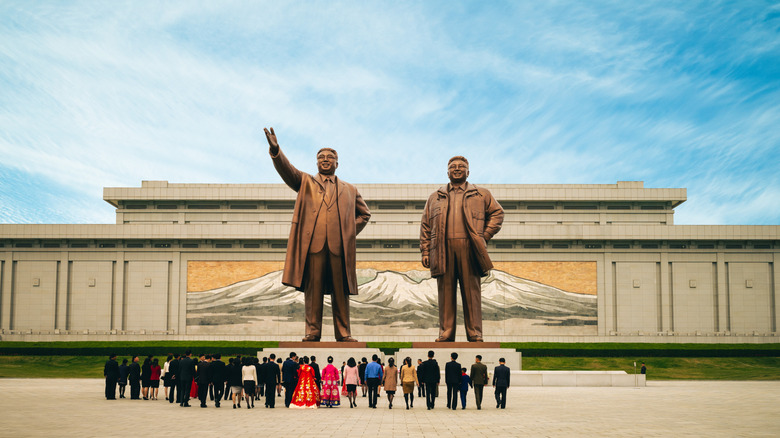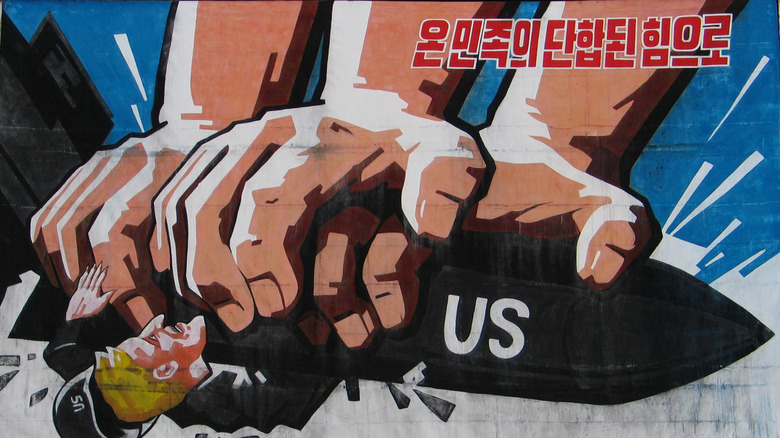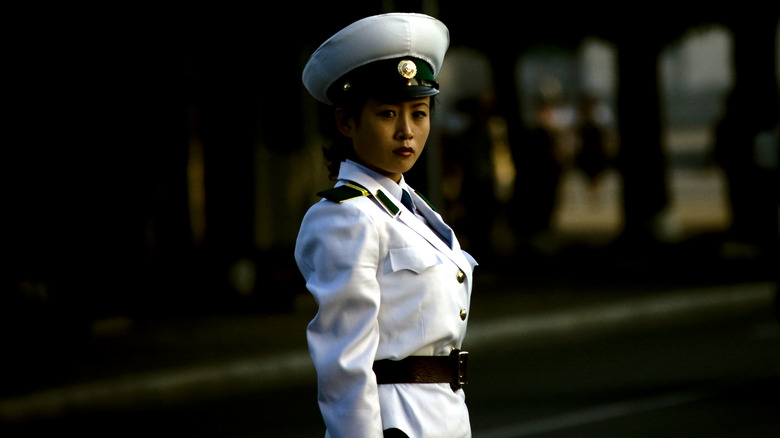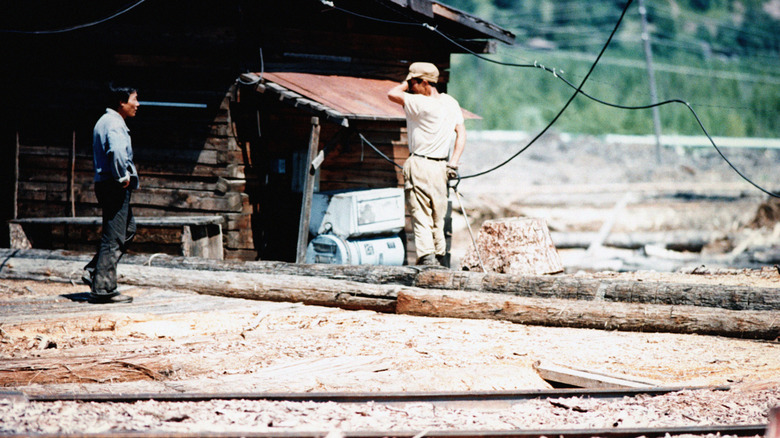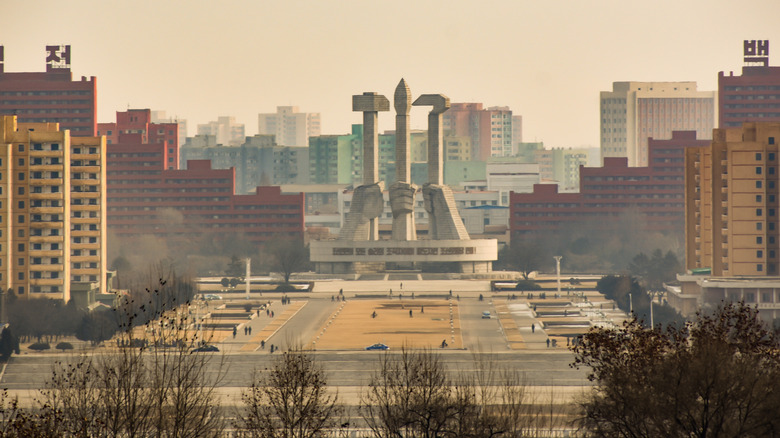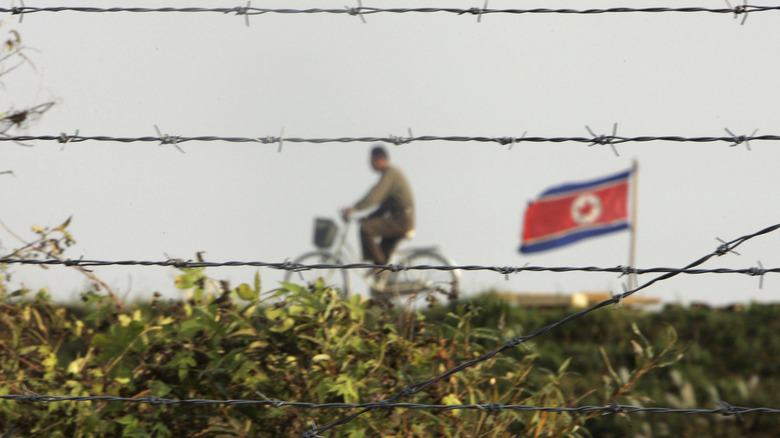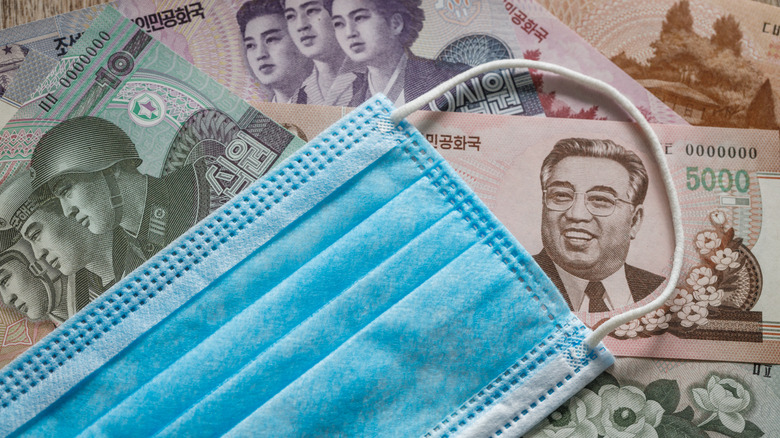What Life Is Really Like In North Korea
By all accounts, North Korea is an unusual place. Everyone knows that. But just how different is it from the rest of the world? Well, sad to say, life in the Democratic People's Republic of Korea (DPRK) goes way, way beyond simply "different." It's repressive, sad, and often deeply disturbing, judging from reports that come out of the hermit kingdom. From forced labor camps to propaganda to no Internet, life seems to be pretty bleak in the world's most restrictive nation.
Under the rule of Supreme Leader Kim Jong Un, who took over the role when his father died in 2011, North Korea has remained mysterious and threatening as a country that invests deeply in its military and nuclear capabilities. All the while, its estimated that 26 million people live in a secluded world in which they are expected to dedicate their entire existence to Kim and his family, who are said to be god-like and capable of impossible feats. Meanwhile, food shortages are not unusual and punishment for any resistance is severe. Here's a look at what life is really like in North Korea.
The propaganda is inescapable
In North Korea, the well-oiled propaganda machine is always working overtime, resulting in an environment in which brainwashing is inescapable. In many ways, today's extreme propaganda in North Korea is heavily influenced by the deceased Kim Jong Il, former Dear Leader and father of current Supreme Leader Kim Jong Un. Kim Jong Il was an avid moviegoer and massive cinephile, who, according to Australia's News.com, believed film was the "most powerful tool for educating the masses," writing in an essay called "Theory of Cinematic Art," that "it is cinema's duty to turn people into true communists." In fact, the Chairman of the Workers' Party of Korea loved film so much, he commissioned the construction of seven cinemas for his use only, proclaimed himself a genius of cinema, and kidnapped a famous director and forced him to create 20 propaganda films, before jailing him for attempting an escape.
Indeed, North Korea's Hollywood of propaganda has worked wonders in creating an environment in which one cannot escape the perpetual bombardment of brainwashing attempts. Everywhere you look, there are posters lining the streets and murals covering every space of available wall.
The propaganda's main function is twofold. First, it aims to inspire nationalism, but not at the expense of love and loyalty to the Supreme Leader. Secondly, it aims to inspire hatred toward the DPRK's enemies.
North Koreans are taught to hate America
Supreme Leader Kim Jong Un wants North Koreans to view America (and Japan) as the enemy. His brainwashing machine churns out anti-American propaganda at a moderately disturbing rate. In March 2017, North Korea released a propaganda video depicting a military strike on an American aircraft carrier in response to the United States' military involvement with neighboring South Korea. According to Military.com, a woman's voice in the video claims "a knife will be stabbed into the throat of the carrier and the bomber will fall from the sky after getting hit by a hail of fire," while depicting the the North Koreans at war with the U.S. and destroying the USS Carl Vinson nuclear-powered aircraft carrier. Of course, it's all fake, but that's not what the people of the DPRK are led to believe.
The country also once released a video depicting a nuclear attack on the White House, and the state educational system indoctrinates children against the U.S. as early as kindergarten — with Associated Press photos depicting North Korean children pretending to attack caricatures of American soldiers, drawing pictures of American military defeat, and anti-American propaganda posters in the primary-school classroom. The country also features a "Struggle Against U.S. Imperialism Month," illustrating that North Korea has certainly not forgotten the Korean War.
Anti-American sentiment is not the only thing North Korean propaganda and education preaches — as they also aren't particularly fond of Japan. Still, at least a minimal level of hatred toward the U.S. is expected in your average, everyday North Korean life.
Children are raised to serve North Korea
Not only can being an adult in North Korea be pretty awful, but growing up there means being indoctrinated from a young age to conform to the stringent rules and expectations of the ruling party. Everything they are taught is within the country's rigid ideology, which can be compressed into the following statement from 14-year-old Kim Myong Hyok, as reported by the Los Angeles Times in 2016: "I want to be in the army and defend our country and our marshal, Kim Jong Un ... The American imperialists and the Japanese are threatening us, so young people should serve in the army."
Many children who aren't lucky enough to live in Pyongyang must spend their formative years performing forced labor on farms or being sent to labor camps. If school buses exist, they are often repurposed dump trucks, which serve as an alternative to walking to school over potentially dangerous terrain.
It probably goes without saying that life in a North Korean orphanage is awful, and those with loving parents still must make regular trips — according to Business Insider — to worship the country's glorious leaders, who themselves insist that North Korean children are the happiest in the world. The DPRK knows that the children are the future, and it appears to be doing the best it can to indoctrinate them into their already incomparably repressive society; however, the birth rate has been declining since about the mid-2010s, and more obviously in the 2020s, per 38North, which is projected to cause labor shortages and put more pressure on citizens.
Everything is a lie
In North Korea, nothing — and we mean nothing — can be taken at face value. In the words of Tim Urban, who wrote in the Huffington Post after visiting the DPRK: "The government lies to the outside world. The government lies to the people. The press lies to the people. The people lie to each other. The tour guides lie to tourists. It's intense."
Urban's description is not surprising, especially when we consider the plethora of propaganda spewed out on a daily basis. And, honestly, how can anyone be expected to tell the truth when your former Supreme Leader was, by various reports, born under a double rainbow and new star, learned to walk at 3 weeks old, learned to talk at 8 weeks old, wrote 1,500 books and six operas — all of which are proclaimed to be the greatest in the history of music — in roughly three years, shot 11 holes-in-one the first time he ever picked up a golf club, became a global fashion icon, was capable of changing the weather with only his mind, invented the hamburger, and never pooped?
Having such a leader doesn't really set a strong precedent for honesty in a society. Even if many outlets tend to exaggerate, if not straight up lie, about the isolated country, there's still an overwhelming amount of viable information to support the idea that life in North Korea is ... well ... fake.
Gender equality isn't necessarily a reality
North Korean propaganda would like you to believe that all the women in the DPRK are very happy and well-respected. But the reality of gender in North Korea is pretty complicated. Traditionally speaking, its society is highly patriarchal, and women are expected to take care of their families at home. Yet the economic and societal pressures they've faced, especially during and after the famine of the 1990s, have shifted the position of women. They began to take leading roles in the unsanctioned markets known as jangmadang, engaging in small-scale capitalism in the midst of what's meant to be a communist regime. Their activity has been tolerated, lest families face even more insecurity, but more recently, those markets have faced increased crackdowns threatening that newfound economic power.
At the same time, increasing numbers of women have been spotted in more powerful or at least prominent positions, including Kim Yo Jong, Kim Jong Un's sister, who has occupied key government posts and sometimes even speaks for the regime, to the point where she's been called the most dangerous woman in the world. Then, there's Kim Jong Un's propaganda-ready wife, Ri Sol Ju, and their daughter, Kim Ju Ae, who seems to be being groomed for a leadership role. Still, while gender relations in North Korea are shifting and the government proclaims that women are equal, it doesn't mean a sea change has happened. Women in the DPRK are reportedly still subject to widespread abuse, including cases involving officials, and remain affected by longstanding patriarchal norms.
There's very little resistance, and any that happens is met with extreme punishment
Perhaps the most alarming thing about life in North Korea — from the perspective of people living in countries where protesting is, more or less, a protected right — is that there's virtually no resistance to the totalitarian government's rule, and any that does exist is met with extreme punishment. Even capturing everyday life on film or watching foreign movies can land one in prison, or worse. It's surprising how many things can get you executed in North Korea.
That being said, some efforts are made to resist one of the world's most repressive totalitarian regimes. Despite the North Korean government's bold anti-American attitudes, the U.S. dollar is still a widely accepted currency, so defectors in China send dollars over the border via balloon. Other forms of resistance have included a South Korean television show — illegal, of course, in North Korea — that features the stories of young defectors.
Still, resistance in the DPRK is minimal, as acts deemed to be criminal are met with unjust and brutal punishments. According to Human Rights Watch, the government of North Korea is known to commit crimes against humanity and incorporates fear tactics to ensure "obedience," including not only forced labor and imprisonment, but also torture and death.
Imagine living in a place where possessing a USB drive with a foreign movie could have you publicly executed. That's pretty scary stuff, to be sure, and serves to illustrate the level of fear present in everyday North Korean society.
The forced-labor camps are horrific
If public executions for seemingly trivial offenses aren't bad enough, North Korea is also home to more than a handful of forced labor camps. If you're a citizen, one wrong move could land you in one of these hells. The same goes if you're a tourist.
For example, if you travel to the DPRK and fancy stealing a propaganda poster as a souvenir, you're looking at 15 years in a forced hard labor camp. In 2016, American college student Otto Warmbier received such a sentence for snagging a poster while on vacation in Pyongyang — deemed by the North Korean state to be, according to The Guardian, "tacit connivance of the U.S. government and its manipulation." While imprisoned, Warmbier was tortured and abused to the point of being severely brain-damaged. In June 2017, he was sent back to the U.S., where he died less than a week later.
In The Guardian, Suzanne Scholte, chairman of the North Korea Freedom Coalition, states: "Conditions [in the forced labor camps] are horrific. People are worked for 14, 15, or 16 hours every day with just a handful of corn to live on, and they are intentionally starved and worked to death ... Torture is common, there's no medical aid, and the sanitation is horrible. They wear the torn uniforms of old prisoners and sleep crammed together in a room."
In 2014, CNN reported on a mother who was beaten and forced to drown her own newborn baby, while also noting the disturbing fact that "North Korean prison camps have survived twice as long as Stalin's Soviet gulags and much longer than the Nazi concentration camps." North Korean camps are full-fledged concentration camps, say some.
Of course, the DPRK denies the existence of these labor camps, but — in reality — these prisons are another means of terrorizing the population of the world's most restrictive country into passivity and submission.
North Koreans have very little knowledge of the outside world
One way in which North Korea effectively controls and subjugates its population is by restricting access to any and all information that doesn't come directly from the mouth of North Korea. According to Human Rights Watch's 2024 World Report, it's considered punishable "anti-socialist" behavior to use unsanctioned sources of media and information, including using radios, phones, TVs, and computers to access anything not approved by the government. Forced labor and torture are on the table for punishments for those offenses. Seems reasonable enough, right? Who really wants Netflix?
North Korea's absurd restriction on information serves to prove New York Times opinion writer Benedict Rogers' assessment as true when he labeled the country the world's most oppressed nation in 2013. Naturally, there's no Internet, unless you count the state-controlled, heavily filtered intranet monitored by the Korea Computer Center. You can get a cell phone, but you can't make calls to anywhere outside of North Korea, and all phone usage is under surveillance. If you are caught using a phone smuggled in from a neighboring country, the Center for Strategic and International Studies says those are grounds for being sent to a reeducation camp.
If you're a foreign journalist, you have to leave your cell phone at home, you shouldn't speak to citizens, and are forbidden from doing anything even remotely journalistic, with someone accompanying or following you, just to make sure. What's more, in Kim Jong-Il's "Guidance for Journalists," it says, "It is advisable that the newspapers carry articles in which they unfailingly hold the president in high esteem, adore him and praise him as the great revolutionary leader" (via the CSIS).
There is no escape
Of course, not everyone in North Korea accepts this existence, and some wish to defect. Defectors, however, are met with severe punishment — not necessarily for themselves, but for generations of their family.
According to The Guardian, Park Sang-hak is a defector and activist who bribed a guard at the border to let him escape in 1999. A couple of years later, he found out that because he did that, two of his uncles were tortured until they died, leaving his teen cousins to fend for themselves in the streets, and his fiancé had been beaten so badly she was permanently disfigured. Children of defectors are forced into labor camps, or worse, as are any other relatives. In many cases, family members who resist forced labor are executed, and anyone who wishes to escape the country must seek out a reputable people smuggler — which is certainly no easy task.
That's really how you know when a country is well and truly twisted — when you can't even leave, for fear that your loved ones will be tortured or killed.
Border control intensified after COVID-19
North Korea's border control has long been part of why it's so dangerous to escape North Korea. Clearly, the regime is not terribly interested in letting people freely cross the borders to the north or south, lest they slip out from under DPRK control. But in certain periods, the border wasn't quite so strictly controlled, like in 1999 when Park Sang-hak got out, or when the post-famine era of the 2000s saw the rise of unsanctioned markets, where everyday North Koreans sold goods that had often been smuggled across the northern border with China. It even occasionally led to claims that North Korea was, in its own small way, turning capitalist.
However, COVID-19 lockdowns have changed that situation dramatically. Where once the border with China was semi-permeable, the pandemic has seemingly given the DPRK an excuse to lock down its border security. Satellite imagery analyzed by the Human Rights Watch showed increased construction at the country's northern border from 2019 to 2023, with more extensive fencing, increased guard posts, and buffer zones that make it more difficult for people to slip through unnoticed. Multiple reports, including those from more recent defectors, claim that North Korean border guards have been ordered to shoot on sight, though North Korea itself has not admitted to such draconian measures. Still, those who have escaped from the country claim that these border crackdowns have increased food insecurity, worsened the health of North Koreans (who can no longer access smuggled medicines), and heightened the sense of fear within the nation.
COVID-19 was hushed up and treatment became scarce
For a while there, you might have convinced yourself that North Korea had escaped the COVID-19 pandemic. The nation is infamously closed off, after all, and regime officials long claimed that no one in North Korea had contracted the disease. But the on-the-ground reality for North Koreans was stark. A 2025 report released by the George W. Bush Presidential Center and the Center for Strategic and International Studies indicates that people in North Korea very definitely came into contact with the disease, with state media sometimes reporting vaguely defined "fever outbreaks." Some respondents said that they were discouraged by doctors from too-accurately describing their symptoms, with some medical professionals dismissing their illnesses as a simple cold. This also complicated reporting illnesses, a key metric for understanding the state of public health in a region.
The crisis was further worsened by a lack of vaccines (North Korea initially rebuffed help importing and distributing COVID-19 vaccines), a dearth of protective equipment like masks, few tests, and a poor supply of medicine to treat those who grew ill. Yet the government did shut down travel within the nation and the quasi-unsanctioned private markets that provided important income to some North Koreans. This contributed to economic instability and worsened an already shaky food supply, putting the health of everyday people in further danger. The DPRK later reported only 74 deaths from COVID, but it seems that hardly anyone — including many North Koreans themselves — really believe that number.
Food shortages are common and hundreds of thousands have starved to death
The food supply in North Korea has always been shaky at best, with agricultural problems caused by overreliance on Soviet help, centralized control of food distribution and farming directives, and an unwillingness to open up trade and accept outside supplies and assistance. In the 1990s, the North Korean people experienced a devastating famine after flooding in 1995 ruined much of the rice harvest. It's unclear just how many people died over the next five years during what was euphemistically called the Arduous March, but estimates tend to land between 600,000 and one million, which the Association for Asian Studies says was about 3 to 5% of North Korea's estimated 20 million people at the time.
That famine alleviated around 2000, but the fears of deadly food shortages haven't gone away. Kim Jong Un announced in 2021 that the country faced a crisis after a disappointing agricultural season. Things were hardly better by 2023, when anonymous North Koreans speaking to the BBC claimed that some of their neighbors had died of starvation. At this point, North Korea's borders were still locked down in response to the COVID-19 pandemic, and grain imports, as well as shipments of agricultural equipment and fertilizer, had ceased.
Defectors have routinely cited tightened food rationing as a major motivation for escaping the country, with some claiming they had received no rations at all. Yet, it appears that the DPRK's government is exercising ever tighter control over the agricultural sector and food supply, echoing conditions that led to the 1990s famine.
